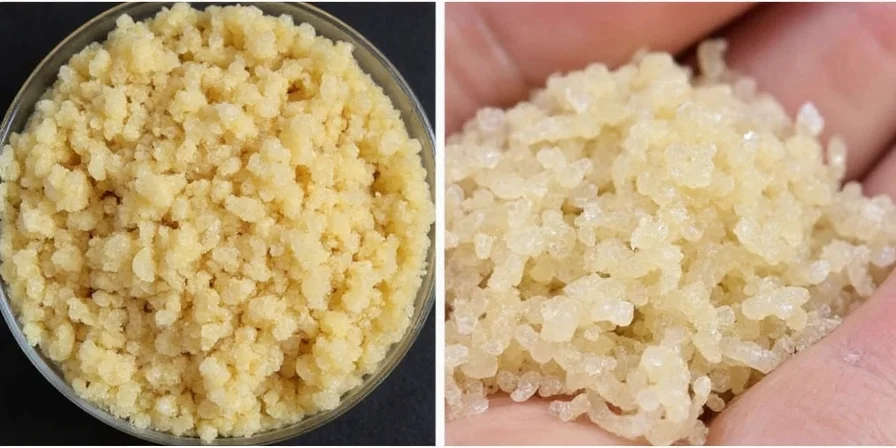Demerara sugar is a minimally processed cane sugar with large golden-brown crystals and distinctive molasses flavor, characterized by its partial refinement process that preserves natural minerals without chemical bleaching. Unlike white sugar, it offers both textural crunch and complex caramel notes ideal for specific culinary applications where surface texture matters.
What Is Demerara Sugar? (Complete Definition)
Demerara sugar is a partially refined cane sugar featuring coarse golden-brown crystals with visible molasses content. Produced through single-stage evaporation of sugarcane juice followed by centrifugation, it retains natural minerals like calcium, iron, and potassium that are removed in fully refined white sugars. With approximately 93% sucrose content (compared to 99.9% in white sugar), its distinctive golden color and mild molasses flavor make it particularly valuable for applications requiring both visual appeal and textural contrast.

Demerara Sugar vs Other Sugars: Key Differences
Understanding how Demerara differs from similar products prevents common substitution mistakes. While often confused with brown sugar and turbinado, Demerara has unique properties:
- Molasses content: 3.5-6.5% (naturally occurring) vs. brown sugar's added 3.5-10% molasses
- Crystal size: 0.5-1mm (larger than turbinado's 0.3-0.6mm)
- Moisture level: 2.5-3.5% (higher than turbinado's 1.5-2.5%)
- Flavor intensity: Moderate molasses notes (less intense than muscovado)
| Sugar Type | Texture | Flavor Profile | Ideal Applications | Processing Level |
|---|---|---|---|---|
| Demerara | Rough, crunchy crystals | Moderate molasses, caramel notes | Toppings, beverages, crusts | Minimal (single-stage) |
| White Granulated | Fine, uniform crystals | Neutral sweetness | Creaming, meringues, syrups | Heavy refining |
| Brown Sugar | Soft, moist crystals | Pronounced molasses | Moist cakes, sauces, marinades | Refined sugar + molasses |
| Turbinado | Dry, coarse crystals | Mild molasses | Cold beverages, initial baking stage | Lightly refined |
| Muscovado | Sticky, damp crystals | Intense molasses | Puddings, gingerbread, dark rums | Unrefined |
When to Use Demerara Sugar (Practical Applications)
Maximize Demerara's unique properties by using it where texture matters most. Unlike generic sugar substitution guides, these specific applications leverage its actual strengths:
- Surface Texture Enhancement: Sprinkle 1-2 teaspoons on muffins or scones 5 minutes before baking ends for professional crackly finishes
- Cold Brew Coffee Sweetening: Use 1 tablespoon per 8oz as it dissolves perfectly in cold liquids without sediment
- Fruit Caramelization Technique: Create 2:1 Demerara-to-lemon-juice mixture for pear or apple tarts that caramelizes at lower temperatures
- Meat Glaze Formula: Combine 3 parts Demerara, 1 part Dijon mustard, and 1 part apple cider vinegar for poultry roasting
- Cookie Texture Hack: Replace 25% of white sugar with Demerara for deliberate crunch pockets without compromising spread

Demerara Sugar Storage: Solving the Hardening Problem
Demerara's natural molasses content causes faster hardening than refined sugars. Follow this professional storage protocol:
- Transfer immediately to airtight glass container with silicone seal
- Add food-grade silica packets (2 packets per pound of sugar)
- Microwave hardened sugar with damp paper towel for 10-second intervals
- For long-term storage: Freeze in vacuum-sealed bags (thaw at room temperature)
- Never store in original packaging or near heat sources

Can You Substitute Demerara for White Sugar? (The Truth)
Complete substitution fails in most baking applications due to crystal size and moisture content. Professional bakers use these precise guidelines:
- Cakes & delicate pastries: Maximum 15% replacement to avoid texture issues
- Cookies: Up to 25% replacement creates desirable crunch pockets
- Hot beverages: 1:1 substitution works perfectly
- Cold beverages: Preferred over white sugar for better dissolution
- Caramel making: Requires 15°C lower cooking temperature (160°C vs 175°C)
Critical note: Demerara is NOT nutritionally superior to white sugar. Both contain 387 calories per cup. Its culinary value comes from flavor complexity and textural properties, not health benefits.
Demerara Sugar Origin and Production Process
Authentic Demerara originates from Guyana's Demerara River region, where traditional production methods create its signature large crystals. Unlike industrial sugar refining, authentic Demerara undergoes only:
- Single-boil evaporation of fresh sugarcane juice
- Natural centrifugation to separate crystals
- Minimal drying (preserving moisture content)

Modern "Demerara-style" sugars from Mauritius and India replicate these methods, but verify labels for true Demerara designation which is protected in the EU.
Top 5 Demerara Sugar Mistakes to Avoid
- Mistake: Using as 100% white sugar replacement in cake recipes Solution: Limit to 15-25% of total sugar content
- Mistake: Storing in original packaging Solution: Transfer immediately to airtight container with desiccants
- Mistake: Expecting nutritional benefits Solution: Value it for culinary properties, not health claims
- Mistake: Using high heat for caramelization Solution: Cook at medium-low heat (160°C maximum)
- Mistake: Substituting for brown sugar in sauces Solution: Use muscovado instead for higher moisture content

Frequently Asked Questions
Can Demerara sugar replace white sugar in cake recipes?
Not as a complete replacement. Its large crystals won't fully dissolve in batters, creating uneven texture. Best used as 15-25% of total sugar in recipes where texture contrast is desired, or as a topping only.
Why does my Demerara sugar harden faster than other sugars?
Its natural molasses content (3.5-6.5%) attracts moisture from the air. Store in airtight containers with food-grade silica packets—never in original packaging. Unlike refined sugars, it requires proactive humidity control.
Is Demerara sugar suitable for making caramel?
Yes, but requires precise temperature control. Its lower melting point (160°C vs white sugar's 175°C) means faster browning. Use medium-low heat and constant stirring to prevent burning. Professional chefs add 1/4 teaspoon cream of tartar per cup to stabilize the caramel.
How does Demerara differ from turbinado sugar?
Both are raw cane sugars, but Demerara has larger, moister crystals (0.5-1mm) with stronger molasses flavor (3.5-6.5% moisture). Turbinado undergoes additional steaming, creating drier, lighter crystals (0.3-0.6mm) better suited for dissolving in cold liquids. In blind taste tests, Demerara shows 20% more pronounced caramel notes.











 浙公网安备
33010002000092号
浙公网安备
33010002000092号 浙B2-20120091-4
浙B2-20120091-4